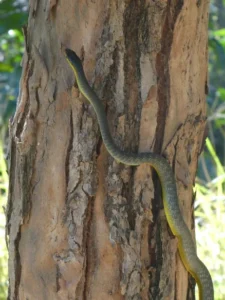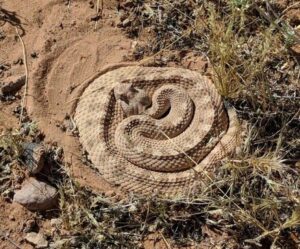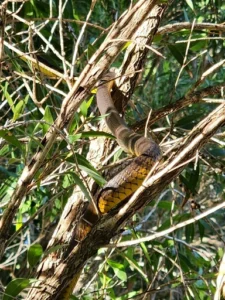Snakes are the most abundant reptiles after Lizards and can be found in various habitats. But have you ever wondered if all snakes can climb trees?
Many snakes can climb trees to some extent, but some are better climbers than others. A snake’s ability to climb trees is mainly influenced by its body structure and habitat.
Arboreal snakes that spend a significant portion of their time in trees or shrubs tend very skilled climbers and can go up a tree within a few minutes.
Terrestrial snakes, on the other hand, are more suited for life on the ground, and may only be able to climb short trees or trees with angled branches.
How Do Snakes Climb Trees?
Snakes use their slender bodies, strong flexible muscles, and rough scales to grip tree bark and branches.
To move upwards, many snakes snakes use a method called ‘concertina locomotion‘, where they grip the surface with side to side S-shaped bends, and pull themselves along.

The scales on a snake’s belly are specialized to provide extra grip, allowing them to cling to rough textures.
Some snakes may even wrap their bodies around the trunk, or branch of a tree in a coiled fashion, to gain extra traction.
Snakes rely on surface friction to climb, so they prefer to climb trees with rough bark that they can grip with ease.
Even skilled climbers may struggle to climb trees with smooth bark, or few branches to cling onto.
Factors That Influence a Snake’s Ability to Climb Trees
There many factors that can influence a snakes ability to climb trees, most notably: body shape & weight, , scale type, natural habitat, and behavior.
1. Body Shape & Weight
The shape of a snake’s body is very important to its climbing ability.
Long, slender snakes with lightweight bodies (eg, vine snakes) tend to be better climbers than shorter or heavy bodied snakes (eg, most vipers).
In many larger snake species such as pythons, juveniles are often better climbers than adults due to their their smaller size and lighter weight.
2. Scale Type
Snakes rely on their scales to grip surfaces. For this reason, the structure of a snake’s scales can affect its climbing ability.
Arboreal snakes tend to have rougher, specialized scales that provide the grip required to scale trees with ease.
Terrestrial snakes, on the other hand, may lack these specialized scales.
3. Natural Habitat
Snakes that live in forested areas are more likely to develop physical adaptations for effective climbing, than those that live on open ground.
For example, desert dwelling snakes like Sidewinders (Crotalus cerastes) have little need to climb trees in their arid habitats.

Green tree pythons (Morelia viridis) on the other hand, live in or near forests and need the ability to climb trees, for survival.
4. Behavior
Snakes that primarily hunt arboreal prey are more likely to develop strong climbing skills than those that hunt aquatic, or terrestrial prey.
Even Highly Terrestrial Snakes May Occasionally Climb Trees
Although terrestrial snakes prefer to stay on the ground, many species can utilize a broad range of habitats, at least occasionally.
Ground dwelling snakes like certain vipers can climb into bushes and low trees.
Some large constrictors, such as boas and pythons, can also ascend vegetation despite their size
6 Reasons Why Some Snakes Climb Trees
There are several reasons why snakes may climb trees. They may be escaping a predator, busking in the sun, or even searching for a meal.
Here are 6 reasons why garter snakes climb trees:
1. Hunting
All snakes are obligate carnivores. Their ability of some snakes to climb trees is very important as they hunt for prey.
Tree-climbing snakes can catch lizards, small mammals, and even small birds in the trees.
Snakes in general are not very picky eaters, and will catch almost any prey they can catch and swallow whole (snakes do not chew their food).
They use their sense of smell, as well as their vision to detect and hunt for prey.
2. Predator Avoidance
Snakes are eaten by a wide variety of predators, such as crows, hawks, foxes, raccoons, and even large frogs.
For this reason, these reptiles developed several ways to defend themselves.
When attacked attacked, many snakes will remain motionless, and rely on their camouflage to blend into their environment.
However, when they are spotted by a predator, they may attempt to escape.
Their ability to climb trees means they can quickly escape predators on land.
3. Thermoregulation
Like all reptiles, snakes are cold-blooded (ectothermic) animals.
This means they cannot internally regulate their body temperature. Instead, their body temperature changes with the temperature in their surroundings.

In other, their environment is the main influence on their body temperature.
As the temperature changes at different times of day and night, they move around in their environment to regulate their body heat. This is known as “thermoregulation..”
Some snakes may climb into trees to warm up and bask in the early morning sunlight.
During the daylight hours when many snakes are more active, ambient temperatures are generally higher on the ground than in trees.
However, this occasionally reverses, such as when the ground is cooled by a light rain – and snakes will climb trees to get warmer temperatures.
4. Avoiding Dangers on the Ground
Sometimes snakes climb trees to avoid various dangers on the ground.
For example, in areas that experience flooding, snakes may climb trees to escape to safety.
Although all snakes can swim, many snakes generally prefer solid ground and avoid flood waters.
Apart from floods, snakes can also climb trees to avoid small fires on the ground.
5. Escaping Aggressive Courtship
During the mating season, some species such as garter snakes often form “mating balls” where one or two females are surrounded by over ten males.
Female snakes often climb trees to escape vigorous courtship. However, they are sometimes still mated by males who manage to follow them in the trees.
6. General Locomotion
Climbing trees is an efficient way for snakes to move around, in a complex environment.
Often, snakes will climb trees simply to move across different areas of their habitat.
Conclusion
Many snakes can use a broad range of habitats, at least occasionally.
Several species are fairly decent climbers, and will sometimes climb trees to bask in the sun, to find food, and to escape predators, among several other reasons.
Sources:
Jayne BC. What Defines Different Modes of Snake Locomotion? Integr Comp Biol. 2020 Jul 1;60(1):156-170. doi: 10.1093/icb/icaa017. PMID: 32271916; PMCID: PMC7391877.
Marvi, Hamidreza & Hu, David. (2010). Concertina locomotion of snakes.
Friction enhancement in concertina locomotion of snakes (PDF).
Hi, my name is Ezra Mushala, i have been interested animals all my life. I am the main author and editor here at snakeinformer.com.

